Attempts to diversify insurers’ executive leadership are often stymied by conservative leadership and cultures, even after years of trying, a recent panel discussion concluded.
“I don’t mean to speak for the industry, but I think historically [when] you look at the P/C industry, there are a lot of mutual companies [for example] in the top 10 in terms of revenue that the corporate structure is very conservative,” Jack Salzwedel, American Family Insurance chairman and CEO, said during a panel discussion on Oct. 13 as part of the all-virtual American Property Casualty Insurance Association annual meeting. “I really think there is bias.”
Explicit and Implicit Bias
Without naming names or the specific company, Salzwedel appeared to indirectly acknowledge the recent departure of several Black executives at AIG and the resulting attention it received in the media, after the issue was raised by panel moderator Leroy Nunery II, founder and principal of PlusUltre LLC, a strategic advisory and consulting company. Salzwedel said the attention comes from increasing sensitivity to explicit or implicit bias that continues to permeate the industry.
“There is bias, and it seeps all the way up to the executive level and causes these situations to happen,” Salzwedel said. “The lack of mentors and allies can contribute to it, but clearly it is an issue in our industry [and] is a really serious issue [for] us to grapple with.”
Panelist Susan Johnson, The Hartford’s chief diversity officer, said it remains important to increase diversity at the executive levels among insurers, despite the continuing challenges Salzwedel mentioned. That’s because potential employees and customers pay close attention, she said.
 “When people look up within the organization, or online at the board of directors, or take a peek at who is in the C-suite, they are looking to see, ‘Does the company reflect people like me?'” – Susan Johnson, Chief Diversity Officer, The Hartford
“When people look up within the organization, or online at the board of directors, or take a peek at who is in the C-suite, they are looking to see, ‘Does the company reflect people like me?'” – Susan Johnson, Chief Diversity Officer, The Hartford“When people look up within the organization, or online at the board of directors, or take a peek at who is in the C-suite, they are looking to see, ‘Does the company reflect people like me?'” Johnson said.
She noted that potential employees and customers are increasingly looking for a company that is “committed to and values diversity” and isn’t afraid to show it. That lack of diversity creates questions, Johnson said, making it important that insurers ask themselves “what we can do to make sure we attract and retain and grow people in equitable ways across the industry.”
That lack of diversity can indicate problems, Johnson said, serving as a “canary in the coal mine” that flags where action is needed.
Johnson said previous research she conducted with Nunery’s firm showed a variety of reasons that address why diversity is lacking and more Black professionals aren’t in insurance industry leadership roles.
“The historical nature of the insurance industry has by itself been conservative,” Johnson explained. “It has a history of redlining, which for some individuals is a hard topic to dissociate from the insurance industry, even though it was decades ago.”
 “There is bias, and it seeps all the way up to the executive level and causes these situations to happen. The lack of mentors and allies can contribute to it, but clearly it is an issue in our industry [and] is a really serious issue [for] us to grapple with.” – Jack Salzwedel, Chairman and CEO, American Family Insurance
“There is bias, and it seeps all the way up to the executive level and causes these situations to happen. The lack of mentors and allies can contribute to it, but clearly it is an issue in our industry [and] is a really serious issue [for] us to grapple with.” – Jack Salzwedel, Chairman and CEO, American Family Insurance Based on the study results, she argued that diversity and inclusion hasn’t moved much past efforts to employ more white women in executive roles. In addition, according to Johnson, organizations aren’t often having tough conversations about the need for more diversity and how to accomplish it.
“Leaders [also] had a lack of exposure to Black talent and really didn’t know Black talent,” Johnson said. “Often times, there was anxiety [around disrupting the status quo].”
Another misconception Johnson heard: the idea that Black job candidates didn’t feel they could meet “unwritten rules” in terms of networking into jobs and promotions.
“Blacks were [also] not viewed as top talent,” she said. “You don’t see them enough at industry awards, [and they’re] not necessarily equitably represented in succession pipelines or top talent lists.”
The Myth of a Diversity Shortage
Some companies have expressed a struggle in finding more diverse employees, and the question came up whether this was a valid statement.
Salzwedel said he’s cringed at the idea.
“That is a common statement you hear from time to time,” he said. “The reality of it is when you start thinking about recruiting, or those groups that have historically been marginalized, [recruiting] has to be done differently…to get women, African Americans, Asians, Hispanics or other diverse groups.”
The idea that more diverse hires are hard to find is “a real misconception and a bias,” Salzwedel said. Diversity is possible, he noted, adding that focusing on employee retention is a next step that enables diversity efforts to have staying power.
“As you start having success with recruiting diverse individuals, the retention of [those] individuals and the word of mouth, and the different groups [they] are aligned with [helps], and then you start to see the world opening up,” Salzwedel said.
In the end, diversity is simply good business in the ongoing effort to reach an increasingly diverse customer base, he insisted.
“There is a business imperative for the next generation of customers” who are seeking diverse leadership in the companies they work with, Salzwedel said. “By 2025, there will be no single majority…Gen Zs out there and millennials are going to expect this and demand it.”
He added that organizations (such as The Hartford with Johnson’s efforts and American Family with Salzwedel’s diversity initiatives) will “be able to leapfrog above others because they are both proactive and looking for long-term changes.
To do the same, senior leaders must “connect the dots between an inclusive workforce, innovation, strategy and the bottom line,” Salzwedel explained.
According to Johnson, that effort is well underway at The Hartford, which is now in its “third iteration” of sequentially developing an ongoing diversity and inclusion culture.
“We’re now going bigger, to work with each line of business to create unit diversity and inclusion action plans, [and they will] then be evaluated and accountable for that over the course of the year,” Johnson said.
Conducting a diversity and inclusion process well can have great benefits for an organization, helping them in “mitigating their own risks” in particular, Johnson said.
She added that diverse and inclusive teams offer “a broad array of thought and not just group think that will help mitigate risk.”





















 Northern California Flooding This Weekend Caused by Heavy Rain, High Tides
Northern California Flooding This Weekend Caused by Heavy Rain, High Tides  NOAA Announces Latest AI-Driven Global Weather Models
NOAA Announces Latest AI-Driven Global Weather Models  Five AI Trends Reshaping Insurance in 2026
Five AI Trends Reshaping Insurance in 2026  Underwriter, Actuary Fears of AI Drop; Work Needed on Collaboration
Underwriter, Actuary Fears of AI Drop; Work Needed on Collaboration 







